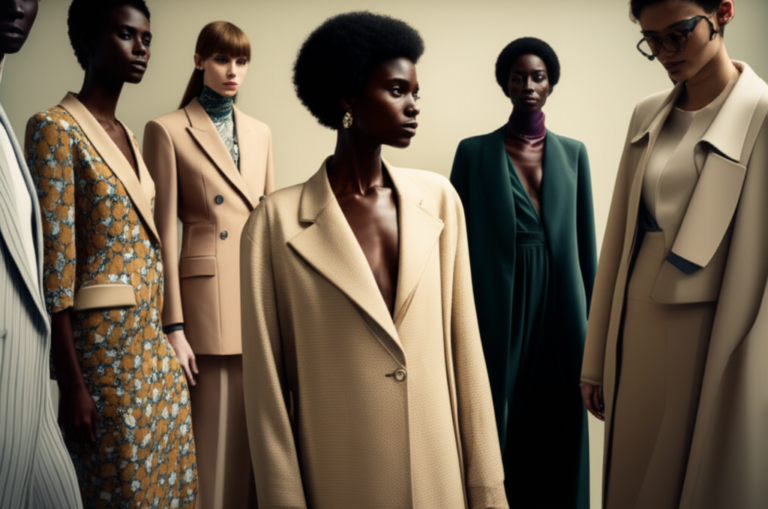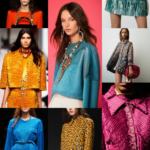Support our educational content for free when you purchase through links on our site. Learn more
The Ultimate Clothing Brands Style Guide: 12 Essentials for 2025 👗

Ever wondered how top clothing brands like Nike and Gucci maintain that flawless, instantly recognizable style across everything they do? Spoiler alert: it’s all thanks to a killer style guide — the secret blueprint that keeps their brand identity sharp, consistent, and unforgettable. Whether you’re launching your own label or refreshing an existing one, mastering the art of a clothing brand style guide can be your game-changer.
In this guide, we unravel the 12 essential pillars every clothing brand needs in its style guide — from crafting your brand’s vision and voice to nailing fabric standards and digital presence. Plus, we’ll share insider tips, real-world examples, and how to keep your style guide fresh in the fast-evolving fashion world. Ready to turn your brand into a style icon? Let’s dive in!
Key Takeaways
- A clothing brand style guide is your brand’s DNA, ensuring consistency and recognition across all platforms and products.
- The guide should cover brand vision, logo, typography, color palette, imagery, fabric standards, sizing, packaging, digital presence, collaborations, sustainability, and innovation.
- Even small brands benefit massively from having a style guide — it saves time, builds trust, and streamlines collaboration.
- Regular audits and updates keep your style guide relevant and aligned with evolving trends and brand growth.
- Learn from fashion giants like Nike, Gucci, and Levi’s, who leverage their style guides to dominate markets and build loyal followings.
👉 Shop iconic brand styles and get inspired:
- Nike Apparel: Amazon | Nike Official
- Gucci Collections: Amazon | Gucci Official
- Levi’s Denim: Amazon | Levis Official
Ready to craft your own style guide that stands out? Keep reading!
Table of Contents
- ⚡️ Quick Tips and Facts
- 🕰️ The Evolution of Brand Identity: A Historical Look at Clothing Style Guides
- 👗 What Exactly is a Clothing Brand Style Guide, Anyway?
- 🎯 Why Your Clothing Brand Absolutely Needs a Style Guide (It’s Not Just for the Big Guys!)
- 🏗️ The Foundational Pillars: Key Elements of a Stellar Clothing Brand Style Guide
- 1. 🎨 Brand Vision & Mission: Your North Star in Fabric Form
- 2. 🗣️ Brand Voice & Tone: Speaking Your Style Story
- 3. ✒️ Logo & Typography Guidelines: The ABCs of Your Brand’s Look
- 4. 🌈 Color Palette & Imagery: Painting Your Brand’s World
- 5. 📸 Photography & Visual Style: Capturing the Essence of Your Collection
- 6. 🧵 Fabric & Material Standards: The Touch and Feel of Your Brand
- 7. 📏 Garment Fit & Sizing Consistency: Ensuring Every Piece Fits Your Promise
- 8. 🏷️ Labeling & Packaging Directives: The Unboxing Experience
- 9. 🌐 Digital & Social Media Presence: Dressing Your Brand for the Online Runway
- 10. 🤝 Collaboration & Partnership Guidelines: Who You Walk the Runway With
- 11. ♻️ Sustainability & Ethical Sourcing Principles: Weaving Values into Your Brand
- 12. 💡 Innovation & Trend Integration: Staying Fresh Without Losing Your Core
- 🛠️ Crafting Your Own Clothing Brand Style Guide: A Step-by-Step Blueprint
- 🔍 Auditing Your Existing Brand Style: Is Your Fashion Identity Still Fresh?
- 🚀 Launching & Living Your Style Guide: Making It Stick Across Your Team
- 📈 Measuring Success: How Do You Know Your Style Guide is Working Its Magic?
- 👗 Different Types of Clothing Brands & Their Unique Style Guide Needs
- 🚫 Common Pitfalls to Avoid When Developing Your Brand’s Style Identity
- 💡 Real-World Inspiration: How Leading Clothing Brands Nail Their Style Guides
- 🌐 The Digital Age & Your Clothing Brand Style Guide: Adapting for Online Dominance
- 🔮 The Future of Fashion Branding: What’s Next for Style Guides?
- ✨ Conclusion: Your Style Guide – The Ultimate Fashion Statement
- 🔗 Recommended Links: Dive Deeper into Brand Brilliance
- 📚 Reference Links: Our Sources for Style Savvy
⚡️ Quick Tips and Facts
A clothing brand style guide is like the fashion bible for your brand. It’s a living document that outlines everything from your logo and color palette to your photography style and even the types of fabrics you use. Think of it as a blueprint for creating a cohesive and recognizable brand identity that resonates with your target audience.
Having a style guide is essential for any clothing brand, big or small. It helps to ensure consistency across all your marketing materials, products, and even your social media presence. This consistency helps to build brand recognition and trust with your customers.
A well-crafted style guide can save you time and money in the long run. By establishing clear guidelines, you can avoid costly mistakes and ensure that your brand is always presented in the best possible light.
Here’s a quick rundown of the key benefits of having a clothing brand style guide:
- Consistency: A style guide ensures that your brand looks and feels the same across all platforms, from your website to your packaging.
- Brand Recognition: A consistent brand identity helps customers easily recognize your brand, even amidst a sea of competitors.
- Efficiency: A style guide streamlines the design process, saving you time and money.
- Collaboration: A style guide provides a shared understanding of your brand’s identity for everyone on your team, from designers to marketing professionals.
- Brand Storytelling: A style guide helps you tell your brand’s story through visual elements, creating a deeper connection with your customers.
Think of your clothing brand style guide as an investment in your brand’s future. It’s a powerful tool that can help you build a strong and lasting presence in the competitive world of fashion.
Want to learn more about how to create a killer clothing brand style guide? Keep reading!
🕰️ The Evolution of Brand Identity: A Historical Look at Clothing Style Guides
The concept of a “style guide” has evolved alongside the fashion industry itself. While the term “style guide” might be relatively new, the idea of establishing visual guidelines for a brand has been around for centuries.
Early examples of brand identity can be traced back to the Renaissance. Think of the iconic logos of famous Italian fashion houses like Gucci and Prada. These brands established their unique visual identities through their logos, color palettes, and signature designs.
The 20th century saw a boom in mass-produced clothing, leading to the rise of branding as we know it today. Brands like Levi’s and Nike used advertising and marketing to create strong brand identities that resonated with consumers.
The digital age has further revolutionized the way brands communicate with their audiences. Today, clothing brands need to be present across multiple platforms, from their website to social media. This has led to the development of more comprehensive style guides that address the unique challenges of the digital landscape.
Want to see how some of the biggest brands in the world have used style guides to build their empires? Check out our section on “Real-World Inspiration: How Leading Clothing Brands Nail Their Style Guides” below!
👗 What Exactly is a Clothing Brand Style Guide, Anyway?
Think of a clothing brand style guide as a comprehensive document that outlines the visual identity of your brand. It’s a guidebook for anyone who works with your brand, from designers to marketing professionals.
Here’s a simple analogy: Imagine you’re building a house. The style guide is like the architectural blueprint. It lays out the foundation, the design elements, and the overall aesthetic of your brand.
A clothing brand style guide typically includes the following elements:
- Logo & Typography: This section defines your brand’s logo, its variations, and the fonts you use.
- Color Palette: This section outlines the colors that represent your brand, including primary, secondary, and accent colors.
- Imagery & Photography: This section defines the visual style of your brand, including the types of images you use and the photography style you prefer.
- Fabric & Material Standards: This section outlines the types of fabrics and materials you use, ensuring consistency across your collections.
- Garment Fit & Sizing: This section defines the fit and sizing of your garments, ensuring consistency across all sizes.
- Labeling & Packaging: This section outlines the labeling and packaging guidelines for your products, ensuring a consistent brand experience.
- Digital & Social Media Presence: This section defines your brand’s online presence, including your website design, social media strategy, and content guidelines.
A clothing brand style guide is a living document that should be updated regularly. As your brand evolves, so too should your style guide.
Ready to dive deeper into the key elements of a stellar clothing brand style guide? Let’s explore the foundational pillars of a successful brand identity!
🎯 Why Your Clothing Brand Absolutely Needs a Style Guide (It’s Not Just for the Big Guys!)
You might be thinking, “I’m a small brand, do I really need a style guide?” The answer is a resounding YES! Even if you’re just starting out, a style guide can be a game-changer for your brand.
Here’s why a style guide is essential for any clothing brand, regardless of size:
- Consistency: A style guide ensures that your brand looks and feels the same across all platforms, from your website to your social media. This consistency helps to build brand recognition and trust with your customers.
- Brand Recognition: A consistent brand identity helps customers easily recognize your brand, even amidst a sea of competitors.
- Efficiency: A style guide streamlines the design process, saving you time and money.
- Collaboration: A style guide provides a shared understanding of your brand’s identity for everyone on your team, from designers to marketing professionals.
- Brand Storytelling: A style guide helps you tell your brand’s story through visual elements, creating a deeper connection with your customers.
Think of your clothing brand style guide as an investment in your brand’s future. It’s a powerful tool that can help you build a strong and lasting presence in the competitive world of fashion.
Ready to learn how to create your own clothing brand style guide? Let’s dive into the step-by-step process!
🏗️ The Foundational Pillars: Key Elements of a Stellar Clothing Brand Style Guide
A strong clothing brand style guide is built on a solid foundation of key elements. These elements work together to create a cohesive and recognizable brand identity that resonates with your target audience.
1. 🎨 Brand Vision & Mission: Your North Star in Fabric Form
Your brand vision and mission are the heart and soul of your clothing brand. They define your purpose, your values, and your aspirations.
Think of your brand vision as a long-term goal. What do you want your brand to achieve? What impact do you want to have on the world?
Your brand mission is a roadmap for achieving your vision. How will you achieve your goals? What are the steps you’ll take to make your vision a reality?
Here are some questions to consider when defining your brand vision and mission:
- What are your core values? What principles guide your brand?
- Who is your target audience? Who are you trying to reach with your brand?
- What makes your brand unique? What sets you apart from your competitors?
- What is your brand’s personality? What kind of feeling do you want your brand to evoke?
Your brand vision and mission should be clear, concise, and inspiring. They should guide all aspects of your brand, from your product design to your marketing strategy.
Ready to dive deeper into the art of crafting a compelling brand voice and tone? Let’s explore the next pillar of a successful style guide!
2. 🗣️ Brand Voice & Tone: Speaking Your Style Story
Your brand voice and tone are the way you communicate with your customers. They reflect your brand’s personality and values.
Think of your brand voice as your unique way of speaking. Is it formal or casual? Is it playful or serious? Is it sophisticated or down-to-earth?
Your brand tone is the emotional impact you want to create. Do you want to be inspiring, empowering, or humorous?
Here are some questions to consider when defining your brand voice and tone:
- What kind of language do you use? Do you use slang, technical jargon, or formal language?
- What is your brand’s attitude? Are you confident, playful, or edgy?
- What kind of emotions do you want to evoke? Do you want to make people feel happy, inspired, or empowered?
Your brand voice and tone should be consistent across all your marketing materials and communications. This helps to create a unified brand experience for your customers.
Ready to learn how to translate your brand’s voice and tone into visual elements? Let’s explore the next pillar of a successful style guide!
3. ✒️ Logo & Typography Guidelines: The ABCs of Your Brand’s Look
Your logo is the visual representation of your brand. It’s the first thing people see when they encounter your brand, so it’s important to make a good first impression.
Your typography guidelines define the fonts you use for your brand. These fonts should reflect your brand’s personality and values.
Here are some questions to consider when developing your logo and typography guidelines:
- What is the purpose of your logo? What message do you want to convey?
- What is the style of your logo? Is it modern, classic, or playful?
- What colors will you use for your logo? These colors should be consistent with your brand’s color palette.
- What fonts will you use for your brand? These fonts should be legible, appropriate for your brand’s personality, and easy to read.
Your logo and typography should be consistent across all your marketing materials and communications. This helps to create a unified brand experience for your customers.
Ready to learn how to create a color palette that reflects your brand’s personality? Let’s explore the next pillar of a successful style guide!
4. 🌈 Color Palette & Imagery: Painting Your Brand’s World
Your color palette is the foundation of your brand’s visual identity. It sets the tone for your brand and evokes certain emotions.
Your imagery is the visual representation of your brand’s story. It helps to bring your brand to life and connect with your customers on an emotional level.
Here are some questions to consider when developing your color palette and imagery guidelines:
- What colors represent your brand? These colors should be consistent with your brand’s personality and values.
- What kind of imagery do you use? Do you use photography, illustrations, or a combination of both?
- What is the style of your imagery? Is it modern, classic, or playful?
- What emotions do you want to evoke with your imagery? Do you want to make people feel happy, inspired, or empowered?
Your color palette and imagery should be consistent across all your marketing materials and communications. This helps to create a unified brand experience for your customers.
Ready to learn how to capture the essence of your collection through photography? Let’s explore the next pillar of a successful style guide!
5. 📸 Photography & Visual Style: Capturing the Essence of Your Collection
Your photography is the window into your brand’s world. It’s how you showcase your products and tell your brand’s story.
Your visual style is the overall aesthetic of your brand. It encompasses everything from your photography style to your graphic design.
Here are some questions to consider when developing your photography and visual style guidelines:
- What is your brand’s photography style? Is it lifestyle, editorial, or product-focused?
- What kind of lighting do you use? Natural light, studio lighting, or a combination of both?
- What is the composition of your photos? Do you use close-ups, wide shots, or a mix of both?
- What is the overall tone of your photography? Is it light and airy, dark and moody, or something in between?
Your photography and visual style should be consistent across all your marketing materials and communications. This helps to create a unified brand experience for your customers.
Ready to learn how to create a brand experience that goes beyond the visual? Let’s explore the next pillar of a successful style guide!
6. 🧵 Fabric & Material Standards: The Touch and Feel of Your Brand
The fabrics and materials you use are an essential part of your brand’s identity. They convey the quality, craftsmanship, and sustainability of your products.
Here are some questions to consider when developing your fabric and material standards:
- What types of fabrics do you use? Natural fibers, synthetic fibers, or a combination of both?
- What are the qualities of your fabrics? Softness, durability, breathability, or a combination of these qualities?
- Where do you source your fabrics? Do you prioritize ethical and sustainable sourcing?
- What are your fabric care instructions? Do you use specific washing or drying methods?
Your fabric and material standards should be consistent across all your collections. This helps to create a unified brand experience for your customers.
Ready to learn how to ensure that every piece of clothing fits your brand’s promise? Let’s explore the next pillar of a successful style guide!
7. 📏 Garment Fit & Sizing Consistency: Ensuring Every Piece Fits Your Promise
Garment fit and sizing are crucial for customer satisfaction. Customers want to know that they can rely on your brand for consistent sizing and a flattering fit.
Here are some questions to consider when developing your garment fit and sizing guidelines:
- What is your brand’s target demographic? This will help you determine the appropriate fit and sizing for your garments.
- What is your brand’s aesthetic? This will help you determine the overall silhouette and fit of your garments.
- What are your sizing standards? Do you use standard sizing charts or create your own?
- How do you ensure consistency in sizing across all your collections? Do you use a specific pattern maker or have a quality control process in place?
Your garment fit and sizing guidelines should be clear and concise. This will help to ensure that your customers have a positive experience with your brand.
Ready to learn how to create an unboxing experience that reflects your brand’s personality? Let’s explore the next pillar of a successful style guide!
8. 🏷️ Labeling & Packaging Directives: The Unboxing Experience
Your labeling and packaging are the first physical touchpoint your customers have with your brand. They should reflect your brand’s personality and values.
Here are some questions to consider when developing your labeling and packaging guidelines:
- What is your brand’s aesthetic? This will help you determine the overall look and feel of your labeling and packaging.
- What materials will you use for your labeling and packaging? Paper, plastic, or a combination of both?
- What information will you include on your labels? Brand name, size, care instructions, or other relevant information?
- What is the overall experience you want to create with your packaging? Do you want to create a luxurious, eco-friendly, or playful experience?
Your labeling and packaging guidelines should be consistent across all your products. This helps to create a unified brand experience for your customers.
Ready to learn how to dress your brand for the online runway? Let’s explore the next pillar of a successful style guide!
9. 🌐 Digital & Social Media Presence: Dressing Your Brand for the Online Runway
In today’s digital age, your online presence is just as important as your physical presence. Your website, social media channels, and online marketing materials should all reflect your brand’s identity.
Here are some questions to consider when developing your digital and social media guidelines:
- What is your brand’s tone of voice online? Is it formal, casual, or playful?
- What is your brand’s visual style online? Do you use photography, illustrations, or a combination of both?
- What is your brand’s content strategy? What kind of content do you create and share?
- What are your social media channels? Do you use Instagram, Facebook, Twitter, or other platforms?
Your digital and social media guidelines should be consistent across all your online platforms. This helps to create a unified brand experience for your customers.
Ready to learn how to build a strong brand through strategic collaborations? Let’s explore the next pillar of a successful style guide!
10. 🤝 Collaboration & Partnership Guidelines: Who You Walk the Runway With
Collaborations and partnerships can be a powerful way to expand your brand’s reach and connect with new audiences. But it’s important to choose partners who align with your brand’s values and aesthetic.
Here are some questions to consider when developing your collaboration and partnership guidelines:
- What are your brand’s values? What kind of partners do you want to work with?
- What is your brand’s aesthetic? What kind of brands do you want to collaborate with?
- What are your goals for collaborations and partnerships? Do you want to reach new audiences, increase brand awareness, or launch new products?
Your collaboration and partnership guidelines should be clear and concise. This will help you to choose partners who are a good fit for your brand.
Ready to learn how to weave sustainability and ethical sourcing into the fabric of your brand? Let’s explore the next pillar of a successful style guide!
11. ♻️ Sustainability & Ethical Sourcing Principles: Weaving Values into Your Brand
Sustainability and ethical sourcing are increasingly important to consumers. By incorporating these values into your brand, you can attract a loyal following of customers who share your commitment to making a positive impact on the world.
Here are some questions to consider when developing your sustainability and ethical sourcing guidelines:
- What are your brand’s sustainability goals? Do you want to reduce your environmental impact, support fair labor practices, or both?
- Where do you source your materials? Do you prioritize sustainable and ethical sourcing?
- What are your manufacturing practices? Do you use eco-friendly materials and processes?
- How do you communicate your sustainability and ethical sourcing practices to your customers? Do you use transparent labeling, share your story on your website, or participate in industry initiatives?
Your sustainability and ethical sourcing guidelines should be clear and concise. This will help you to build a brand that is both stylish and sustainable.
Ready to learn how to stay fresh and innovative without losing your brand’s core? Let’s explore the next pillar of a successful style guide!
12. 💡 Innovation & Trend Integration: Staying Fresh Without Losing Your Core
The fashion industry is constantly evolving. To stay ahead of the curve, you need to be innovative and adapt to new trends.
Here are some questions to consider when developing your innovation and trend integration guidelines:
- What are the current trends in the fashion industry? How can you incorporate these trends into your brand in a way that is authentic and relevant?
- What are your brand’s core values? How can you stay true to your brand’s identity while embracing new trends?
- How can you innovate within your brand? Can you experiment with new materials, silhouettes, or designs?
Your innovation and trend integration guidelines should be flexible and adaptable. This will help you to stay ahead of the curve and keep your brand fresh and exciting.
Ready to learn how to craft your own clothing brand style guide? Let’s dive into the step-by-step process!
🛠️ Crafting Your Own Clothing Brand Style Guide: A Step-by-Step Blueprint
Creating a clothing brand style guide is a process that requires careful planning and execution. Here’s a step-by-step blueprint to help you get started:
- Define Your Brand Identity: Start by defining your brand’s vision, mission, values, and personality. What makes your brand unique? Who is your target audience? What kind of feeling do you want your brand to evoke?
- Develop Your Logo & Typography: Create a logo that is visually appealing, memorable, and reflects your brand’s identity. Choose fonts that are legible, appropriate for your brand’s personality, and easy to read.
- Create Your Color Palette: Select colors that represent your brand’s personality and values. Consider using a color wheel to create a harmonious palette.
- Define Your Imagery & Photography Style: Determine the types of images you will use for your brand. Do you prefer photography, illustrations, or a combination of both? What is the overall tone and style of your imagery?
- Establish Your Fabric & Material Standards: Outline the types of fabrics and materials you will use for your products. Prioritize quality, sustainability, and ethical sourcing.
- Develop Your Garment Fit & Sizing Guidelines: Define the fit and sizing of your garments. Ensure consistency across all sizes and collections.
- Create Your Labeling & Packaging Directives: Design labels and packaging that reflect your brand’s personality and values. Consider the overall unboxing experience you want to create.
- Define Your Digital & Social Media Presence: Establish your brand’s online presence. Develop a website, social media strategy, and content guidelines that are consistent with your brand’s identity.
- Develop Your Collaboration & Partnership Guidelines: Outline your criteria for choosing partners. Prioritize brands that align with your brand’s values and aesthetic.
- Incorporate Sustainability & Ethical Sourcing Principles: Define your brand’s commitment to sustainability and ethical sourcing. Communicate these values to your customers.
- Embrace Innovation & Trend Integration: Stay ahead of the curve by incorporating new trends into your brand in a way that is authentic and relevant.
Remember, your clothing brand style guide is a living document. As your brand evolves, so too should your style guide.
Ready to take your style guide to the next level? Let’s explore how to audit your existing brand style and ensure it’s still fresh and relevant!
🔍 Auditing Your Existing Brand Style: Is Your Fashion Identity Still Fresh?
Just like a well-tailored suit needs a refresh every now and then, your brand style needs a periodic audit. This ensures that your brand remains relevant and resonates with your target audience.
Here’s a checklist to help you audit your existing brand style:
- Vision & Mission: Are your brand’s vision and mission still relevant? Do they accurately reflect your brand’s current goals and values?
- Logo & Typography: Is your logo still visually appealing and memorable? Are your fonts still legible and appropriate for your brand’s personality?
- Color Palette: Are your brand colors still fresh and vibrant? Do they still evoke the desired emotions?
- Imagery & Photography: Is your imagery still consistent with your brand’s aesthetic? Does it still resonate with your target audience?
- Fabric & Material Standards: Are you still using high-quality, sustainable, and ethically sourced materials?
- Garment Fit & Sizing: Are your sizing standards still consistent and accurate?
- Labeling & Packaging: Does your labeling and packaging still reflect your brand’s personality and values?
- Digital & Social Media Presence: Is your online presence still consistent with your brand’s identity? Are you using the right platforms and creating the right content?
- Collaboration & Partnership Guidelines: Are you still working with partners who align with your brand’s values and aesthetic?
- Sustainability & Ethical Sourcing Principles: Are you still committed to sustainability and ethical sourcing? Are you communicating these values to your customers?
- Innovation & Trend Integration: Are you still embracing new trends in a way that is authentic and relevant to your brand?
If you find that your brand style is no longer meeting your needs, it’s time to make some changes. Don’t be afraid to experiment and evolve your brand’s identity.
Ready to launch your style guide and make it stick across your team? Let’s explore the next steps!
🚀 Launching & Living Your Style Guide: Making It Stick Across Your Team
Once you’ve created your clothing brand style guide, it’s time to launch it and make it a part of your team’s daily workflow. Here are some tips for ensuring that your style guide is used and respected:
- Communicate Clearly: Explain the purpose of the style guide to your team and why it’s important for the success of your brand.
- Make It Accessible: Store your style guide in a central location that is easily accessible to everyone on your team.
- Provide Training: Offer training sessions to help your team understand the style guide and how to use it.
- Encourage Feedback: Ask your team for feedback on the style guide and make adjustments as needed.
- Enforce Consistency: Hold your team accountable for adhering to the style guide.
- Celebrate Success: Recognize and reward team members who consistently follow the style guide.
Remember, your style guide is a living document. As your brand evolves, so too should your style guide. Be sure to review and update it regularly to ensure that it remains relevant and effective.
Ready to measure the success of your style guide? Let’s explore how to track its impact on your brand!
📈 Measuring Success: How Do You Know Your Style Guide is Working Its Magic?
You’ve created your clothing brand style guide, launched it, and made it a part of your team’s workflow. But how do you know if it’s actually working its magic?
Here are some key metrics to track the success of your style guide:
- Brand Recognition: Are customers easily recognizing your brand? Are they mentioning your brand’s unique features or style?
- Consistency: Are your marketing materials, products, and online presence all consistent with your brand’s identity?
- Customer Satisfaction: Are customers happy with the quality and consistency of your products and brand experience?
- Team Adoption: Is your team consistently adhering to the style guide? Are they using it as a reference for all their work?
You can also track the success of your style guide by analyzing customer feedback, website traffic, social media engagement, and sales data. Look for trends and patterns that indicate whether your style guide is helping to achieve your brand’s goals.
Ready to learn how different types of clothing brands have unique style guide needs? Let’s explore the next step!
👗 Different Types of Clothing Brands & Their Unique Style Guide Needs
Not all clothing brands are created equal. Different types of brands have unique needs and requirements for their style guides.
Here are some examples of different types of clothing brands and their unique style guide needs:
- Luxury Brands: Luxury brands often have very detailed style guides that focus on creating a premium and exclusive brand experience. They may have specific guidelines for everything from the types of fabrics they use to the way their products are displayed in stores.
- Fast Fashion Brands: Fast fashion brands need to be agile and responsive to changing trends. Their style guides may be more flexible and adaptable to allow for quick changes in design and production.
- Sustainable Brands: Sustainable brands need to communicate their commitment to ethical and environmentally friendly practices. Their style guides may include guidelines for sourcing materials, manufacturing processes, and packaging.
- Athleisure Brands: Athleisure brands need to convey a sense of comfort, performance, and style. Their style guides may include guidelines for the types of fabrics they use, the fit of their garments, and the overall aesthetic of their brand.
- Streetwear Brands: Streetwear brands often have a strong emphasis on individuality and self-expression. Their style guides may be more relaxed and allow for more creative freedom.
No matter what type of clothing brand you have, it’s important to create a style guide that meets your unique needs. This will help you to build a strong and recognizable brand identity that resonates with your target audience.
Ready to avoid common pitfalls when developing your brand’s style identity? Let’s explore the next step!
🚫 Common Pitfalls to Avoid When Developing Your Brand’s Style Identity
Creating a clothing brand style guide is a journey, not a destination. Along the way, you may encounter some common pitfalls that can derail your efforts.
Here are some common pitfalls to avoid:
- Not Defining Your Target Audience: If you don’t know who you’re trying to reach, you can’t create a style guide that resonates with them.
- Not Being Consistent: Your brand identity should be consistent across all your marketing materials, products, and online presence.
- Not Being Authentic: Your brand should reflect your true values and personality. Don’t try to be something you’re not.
- Not Being Flexible: Your style guide should be a living document that can be updated as your brand evolves.
- Not Getting Feedback: Ask your team and customers for feedback on your style guide. They can provide valuable insights that can help you improve it.
By avoiding these common pitfalls, you can create a clothing brand style guide that helps you build a strong and lasting brand identity.
Ready to see how leading clothing brands nail their style guides? Let’s explore the next step!
💡 Real-World Inspiration: How Leading Clothing Brands Nail Their Style Guides
Want to see how some of the biggest brands in the world have used style guides to build their empires? Here are a few examples of clothing brands that have created stellar style guides:
- Nike: Nike’s style guide is a classic example of a strong brand identity. It’s known for its iconic logo, bold color palette, and powerful imagery. Nike’s style guide has helped to create a brand that is synonymous with athleticism, performance, and innovation.
- Apple: Apple’s style guide is a testament to the power of simplicity and elegance. It’s known for its clean lines, minimalist design, and focus on user experience. Apple’s style guide has helped to create a brand that is synonymous with quality, innovation, and design.
- Gucci: Gucci’s style guide is a celebration of Italian luxury and craftsmanship. It’s known for its bold colors, intricate patterns, and luxurious materials. Gucci’s style guide has helped to create a brand that is synonymous with style, sophistication, and exclusivity.
- Levi’s: Levi’s style guide is a testament to the power of heritage and authenticity. It’s known for its iconic denim, classic designs, and timeless appeal. Levi’s style guide has helped to create a brand that is synonymous with American style, durability, and individuality.
- Supreme: Supreme’s style guide is a reflection of its street-inspired aesthetic. It’s known for its bold graphics, limited-edition releases, and cult following. Supreme’s style guide has helped to create a brand that is synonymous with exclusivity, hype, and streetwear culture.
These are just a few examples of clothing brands that have successfully used style guides to build their brands. By studying these examples, you can gain valuable insights into the key elements of a successful style guide.
Ready to learn how to adapt your style guide for the digital age? Let’s explore the next step!
🌐 The Digital Age & Your Clothing Brand Style Guide: Adapting for Online Dominance
The digital age has revolutionized the way brands communicate with their audiences. Clothing brands need to be present across multiple platforms, from their website to social media. This has led to the development of more comprehensive style guides that address the unique challenges of the digital landscape.
Here are some key considerations for adapting your clothing brand style guide for the digital age:
- Website Design: Your website should be visually appealing, easy to navigate, and consistent with your brand’s identity.
- Social Media Strategy: Develop a social media strategy that aligns with your brand’s values and goals. Create engaging content that resonates with your target audience.
- Content Guidelines: Establish clear content guidelines for your website and social media channels. This will help to ensure that all your content is consistent with your brand’s voice and tone.
- Email Marketing: Your email marketing campaigns should be visually appealing, informative, and consistent with your brand’s identity.
- Online Advertising: Your online advertising campaigns should be targeted, engaging, and consistent with your brand’s message.
By adapting your clothing brand style guide for the digital age, you can create a strong online presence that helps you reach new customers and build a loyal following.
Ready to peek into the future of fashion branding? Let’s explore the next step!
🔮 The Future of Fashion Branding: What’s Next for Style Guides?
The fashion industry is constantly evolving, and so too are the ways brands communicate with their audiences. Here are some predictions for the future of fashion branding and style guides:
- Increased Personalization: Brands will increasingly use data and technology to personalize the customer experience. This will require more flexible and adaptable style guides that can accommodate individual preferences.
- Focus on Sustainability: Sustainability will continue to be a major trend in the fashion industry. Brands will need to incorporate sustainability into their style guides, from sourcing materials to packaging.
- Emphasis on Inclusivity: Brands will need to be more inclusive and representative of diverse audiences. This will require style guides that reflect a wider range of body types, skin tones, and cultural backgrounds.
- Integration of Augmented Reality (AR) and Virtual Reality (VR): AR and VR technologies will play a bigger role in the fashion industry. Brands will need to develop style guides that incorporate these technologies to create immersive and engaging brand experiences.
The future of fashion branding is exciting and full of possibilities. By staying ahead of the curve and adapting their style guides, brands can create a lasting impact on the industry.
Ready to wrap up our journey into the world of clothing brand style guides? Let’s explore the final step!
Conclusion: Your Style Guide – The Ultimate Fashion Statement

Wow, what a journey! From the foundational pillars of brand vision and logo design to the nitty-gritty of fabric standards and digital presence, we’ve covered the full runway walk of creating a clothing brand style guide that truly shines. Remember, your style guide is much more than a document — it’s the DNA of your brand, the secret sauce that keeps your identity consistent, recognizable, and irresistible to your audience.
Whether you’re a scrappy startup or a seasoned fashion house, a well-crafted style guide is your best friend. It saves time, builds trust, and ensures your brand speaks with one confident, stylish voice. Plus, it helps you avoid those cringe-worthy mismatches that can confuse customers and dilute your brand power.
We opened the loop on how iconic brands like Nike, Gucci, and Levi’s use their style guides to dominate the market — now you have the tools to do the same. Keep your guide living and breathing, updating it as trends evolve and your brand grows. And don’t forget: authenticity and consistency are your north stars.
Ready to turn your clothing brand into a style icon? Start building that style guide today — your future customers will thank you! 🚀👗✨
Recommended Links: Dive Deeper into Brand Brilliance
👉 Shop Iconic Clothing Brands & Style Guide Inspirations:
- Nike Official Store: Amazon | Nike.com
- Gucci Official Store: Amazon | Gucci.com
- Levi’s Official Store: Amazon | Levis.com
- Supreme Official Store: Amazon | Supremenewyork.com
Must-Read Books on Branding & Fashion Style Guides:
- Building a StoryBrand: Clarify Your Message So Customers Will Listen by Donald Miller
Amazon Link - Fashion Branding Unraveled by Kaled K. Hameide
Amazon Link - Designing Brand Identity by Alina Wheeler
Amazon Link
FAQ

What are the key elements of a clothing brand’s style guide?
A clothing brand’s style guide typically includes:
- Brand Vision & Mission: The core purpose and values.
- Logo & Typography: Visual symbols and fonts.
- Color Palette: Signature colors that evoke brand emotions.
- Imagery & Photography Style: Visual storytelling elements.
- Fabric & Material Standards: Quality and sustainability benchmarks.
- Garment Fit & Sizing: Consistency in product sizing.
- Labeling & Packaging: Physical brand touchpoints.
- Digital & Social Media Guidelines: Online brand expression.
- Collaboration & Sustainability Principles: Ethical and partnership standards.
- Innovation & Trend Integration: Staying relevant without losing identity.
Each element ensures your brand is cohesive and memorable.
How do clothing brands create a consistent visual identity?
Consistency comes from strict adherence to the style guide across all touchpoints — from product design and packaging to marketing and social media. Brands use:
- Standardized logos and colors to maintain visual uniformity.
- Typography rules for all communications.
- Photography styles that reflect the brand’s personality.
- Fabric and fit standards to ensure product consistency.
- Training and accessible documentation so every team member knows the rules.
This disciplined approach builds trust and recognition.
What is the importance of a style guide in the fashion industry?
In fashion, trends change fast, but brand identity must remain steady. A style guide:
- Protects brand integrity by preventing inconsistent messaging.
- Speeds up design and marketing workflows by providing clear rules.
- Facilitates collaboration with partners, manufacturers, and creatives.
- Builds customer loyalty through a recognizable and trustworthy brand experience.
- Supports scalability as the brand grows and enters new markets.
Without it, brands risk confusion and diluted impact.
Read more about “What is the Biggest Clothing Brand in the World? Discover 10! 👗”
How do popular clothing brands use their style guide to influence consumer behavior?
Brands like Nike and Gucci use their style guides to craft a powerful emotional connection with consumers. They:
- Use consistent visual cues that evoke aspiration, quality, or exclusivity.
- Maintain a distinct voice and tone that resonates with their audience.
- Align product design and marketing to reinforce their brand story.
- Leverage social proof and lifestyle imagery to inspire purchase decisions.
This strategic consistency builds brand loyalty and drives sales.
What are some common mistakes to avoid when creating a clothing brand style guide?
Avoid these pitfalls:
- ❌ Being too vague or overly complex: Your guide should be clear and user-friendly.
- ❌ Ignoring your target audience: The guide must reflect who you want to reach.
- ❌ Lack of flexibility: Brands evolve; your guide should too.
- ❌ Neglecting digital platforms: Online presence is crucial.
- ❌ Not involving your team: Collaboration ensures adoption and relevance.
Steer clear of these to create a guide that truly empowers your brand.
How often should a clothing brand update its style guide to stay relevant?
At least annually, or whenever you:
- Launch a new product line or collection.
- Rebrand or pivot your brand strategy.
- Notice inconsistencies creeping into your brand materials.
- Respond to significant market or trend shifts.
Regular updates keep your brand fresh and aligned with your evolving vision.
Can a well-crafted style guide help a clothing brand stand out in a competitive market?
Absolutely! A style guide is your secret weapon to stand out by:
- Ensuring every customer touchpoint is on-brand and memorable.
- Building trust through consistency.
- Allowing you to tell a compelling brand story that resonates.
- Helping your team and partners work efficiently and cohesively.
In a crowded market, a strong style guide is what separates the fashion icons from the also-rans.
Reference Links: Our Sources for Style Savvy
- Fashion Brand Style Guide: Building a Strong Fashion Brand Identity
- Nike Brand Guidelines
- Gucci Official Website
- Levi’s Brand Information
- Supreme New York
- Building a StoryBrand by Donald Miller
- Designing Brand Identity by Alina Wheeler
- Sustainable Fashion Practices – Ethical Fashion Forum
- The Future of Fashion Branding – Forbes
Ready to craft your own style guide and make your clothing brand unforgettable? We’re here to help you every step of the way! 👗✨







